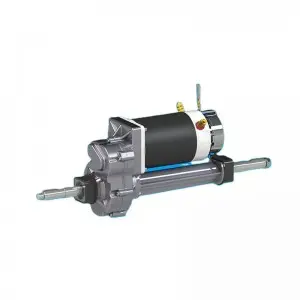The transaxle is a critical component in many modern vehicles, especially those with front-wheel drive configurations. It combines the functions of the transmission, differential and transaxle into a single unit, resulting in efficient power transmission from the engine to the wheels. However, like any mechanical system, the transaxle can experience problems, and one of the most worrisome is a tearing clutch. In this article, we’ll explore what happens to the transaxle when a clutch tear occurs, symptoms to watch for, potential causes, and necessary steps for repair and maintenance.
Understand the transaxle
Before we delve into the effects of a ripped clutch, it’s necessary to understand the role of the transaxle. The transaxle is responsible for:
- Power Distribution: It transmits power from the engine to the wheels, allowing the vehicle to move.
- Shift: It enables the driver to shift gears, optimizing performance and fuel efficiency.
- Differential Action: It allows the wheels to rotate at different speeds, which is crucial when cornering.
Given its multifaceted role, any failure within the transaxle can cause serious performance issues.
What is a clutch tear?
Clutch tear refers to damage or wear to the clutch assembly, a critical component of the transaxle. The clutch is responsible for engaging and disengaging the engine from the transmission, allowing for smooth gear changes. When a clutch tears, it can cause a variety of problems, including slipping, difficulty shifting, or even complete transaxle failure.
Symptoms of a torn clutch
Identifying a clutch tear early can prevent further transaxle damage. Here are some common symptoms to watch out for:
- Clutch Slip: If you notice the engine speed but the vehicle is not accelerating as expected, this may indicate that the clutch is slipping due to tearing.
- Difficulty Shifting: If you encounter resistance or grinding sounds when shifting gears, it may be a sign of clutch damage.
- Unusual Noises: Grinding, whining, or dinging sounds when engaging the clutch may indicate internal damage.
- Burning Smell: A burning smell, especially when the clutch is engaged, may indicate overheating due to excess friction from a tearing clutch.
- Fluid Leak: If you notice fluid collecting underneath your vehicle, it may indicate a leak in the hydraulic system that operates the clutch.
What happens to a transaxle with a torn clutch?
When a clutch tear occurs, the transaxle can experience a host of problems that affect its functionality. Here’s what might happen:
1. increased wear
A torn clutch can cause increased wear on the transaxle components. The clutch is designed to engage and disengage smoothly; however, when it tears, it can cause erratic engagement. This erratic behavior can cause excessive stress on the gears and bearings within the transaxle, leading to premature wear.
2. Overheating
A damaged clutch can cause the transaxle to overheat. When a clutch slips, excess heat is generated due to friction. This heat can be transferred to the transaxle, causing thermal expansion and potential damage to internal components. Overheating can also reduce the performance of the transmission fluid, reducing its lubrication and cooling effectiveness.
3. Power Transmission Loss
One of the transaxle’s primary functions is to transfer power from the engine to the wheels. A ripped clutch disrupts this power transfer, resulting in reduced acceleration and overall performance. In severe cases, the vehicle may not be able to drive.
4. Possibility of complete failure
If left unaddressed, a ripped clutch can lead to complete transaxle failure. Internal components can become so damaged that they no longer function properly, requiring expensive replacement of the entire transaxle. That’s why early detection and remediation is crucial.
Causes of clutch tearing
Understanding the causes of clutch tear can help with prevention and maintenance. Some common reasons include:
- Wear: Over time, clutch components naturally wear out from regular use.
- Improper Installation: If the clutch is installed incorrectly, it may cause uneven wear and premature failure.
- OVERHEAT: Excessive heat from vigorous driving or towing can cause clutch material to degrade.
- Fluid Leak: Low hydraulic fluid levels can cause insufficient pressure, causing the clutch to slip and tear.
- Driving Habits: Aggressive driving, such as quick starts and stops, can put extra stress on the clutch.
Repair and Maintenance
If you suspect your vehicle’s transaxle is having problems due to a torn clutch, you must take immediate action. Here are some steps to consider:
1. Diagnostic Check
Take your vehicle to a qualified mechanic for a diagnostic inspection. They can evaluate the condition of the clutch and transaxle, identifying any potential problems.
2. Fluid Check
Check transmission fluid level and condition. If the fluid is low or contaminated, it may need to be replaced.
3. Clutch Replacement
If the clutch is found to be torn or damaged, it may need to be replaced. This process involves removing the transaxle, replacing clutch components, and reassembling the unit.
4. Regular Maintenance
To prevent future problems, follow a regular maintenance schedule. This includes checking fluid levels, inspecting the clutch, and promptly addressing any symptoms.
5. Driving Habits
Adopting smoother driving habits can also extend the life of your clutch and transaxle. Avoid harsh starts and stops, and be careful about how you engage the clutch.
in conclusion
The transaxle is an important part of your vehicle, and a ripped clutch can have serious effects on its performance and longevity. By understanding the symptoms, causes, and necessary maintenance, you can take proactive steps to ensure your vehicle remains in top condition. Regular inspections and timely repairs can save you expensive replacement costs and keep your vehicle running smoothly for years to come. If you suspect any problems with the transaxle or clutch, consult a professional mechanic immediately so the problem can be resolved before it escalates.
Post time: Oct-09-2024


